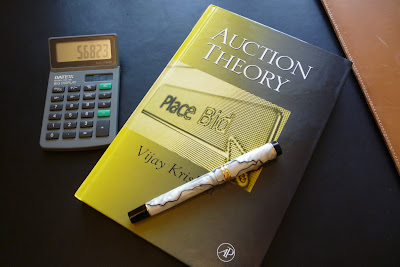Link: Results of Spectrum Experiment
Our first variant in the spectrum auctions experiment was the Vickrey auction. William Vickrey first designed this auction in a single unit context in order to obtain truthful revelation of values as a dominant strategy. The key point of the auction is that your bid only determines the threshold price for winning and losing. It does not determine the price you pay. When there's only a single object, it is easy to see how this works. Since I pay the amount of the second highest bid, my bid merely determines the maximum price I could possibly pay. As such, I can do no better than to set this threshold equal to my value.
Things are more complicated when there are many objects and synergies. The Vickrey principle is that you pay the amount of the harm you do to the values of other. Again, with one object the "harm" done to bidder 2 is equal to her valuation (which is her bid amount as well). Thus, paying the second highest price compensates for the harm. In the multi-object case, the harm consists of computing the allocation of the goods absent bidder 1 (say) and then the allocation with bidder 1 present. The difference in the valuations (expressed in bid amounts) of the others is the amount of the harm.
Most teams had an intuitive grasp that bidding truthfully was the best strategy.
Vickrey auctions are unpopular in practice for several reasons. First, they are hard to explain. Second, the high bidder does not always pay the highest amount. Third, when there are a large number of items, the auction becomes unmanageable. Finally, and we failed to mention this in class, for bidders with budgets, determining the right bid is difficult. A conservative approach is simply to bid up to your budget, but this merely ensures you'll have money left over and won't net you the objects necessarily. On the other hand, bidding your value when it's above your budget exposes you to the risk of going over budget.
Next, we studied the simultaneous ascending auction. This auction is simple to manage and easier to understand. The key difficulty is working out the right bidding strategy with synergies. Bidding with the synergy in mind creates the "exposure problem"---bidders are exposed to the risk that they won't get one of the objects and the anticipated synergies will then not be realized. This can create cautious bidding yielding low revenues and low value created.
Please input your profits from this experiment to the P&L spreadsheet.

No comments:
Post a Comment